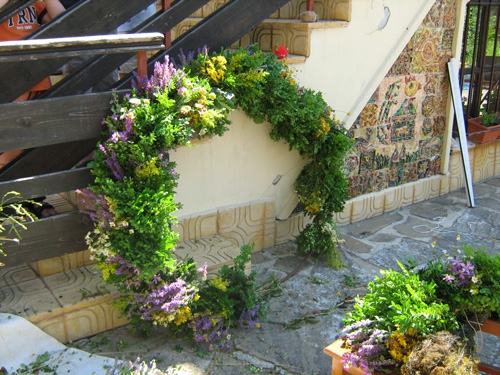The Enyо's wreath in the Ethnographic Museum is made of 77 herbs
Enyo's Day, Enyovden, Midsummer or Summer Ivan is one of the biggest summer holidays associated with the flowering of nature. From this moment the sun begins to die (the day decreases) and the year tends to winter. In the minds of our ancestors, Midsummer's Day is a turning point that already points to the end of summer. People say: "The cuckoo cries until Midsummer's Day and then becomes dumb. Saint Enyo is already renting a yamurluka and is going with his white horse to the Balkans to collect the winter. ”
This day is associated with the summer solstice and various ritual, magical practices are performed, a reflection of the cult of the sun. In some villages, people bathe in rivers before sunrise. This rite is mandatory for girls and bachelors. In other villages, mothers bathe their children with a decoction of the herbs collected.
Herbs harvested early in the morning increase their healing power. According to popular belief, there are 77 and a half diseases. Seventy-seven of them can be treated with herbs, but for half there is no herb. But our ancestors also found a car on this - after 77 herbs are collected, they grind and tear off some grass, which they cut in half together with the flower, and here is the half herb for the half disease. It is obligatory to pick yarrow (yarrow), St. John's wort, black elderberry, basil… These herbs are used to make yang's wrist, which serves as a remedy throughout the year. It is very important that when they go to pick herbs, herbalists, fortune tellers and wizards are not seen by anyone. That's why they go out on the first roosters and go to the most remote places.
People also believe in the magical power of the New Year's dew. This faith finds its expression in the characteristic for the holiday plunder, deception of the fruit from fields and cattle. The person who performs the magical acts is a woman who is called a warden. Casting spells, she drags an apron through other people's fields and plucks the dew to squeeze it into her fields. And just as we all know that there is an equal opposition to every action, so the master of the fields himself reaps it against the feast, in the middle or in the four corners, in order for the wheat mill to find it already "harvested".
In the morning, everyone watches the sun rise. It is believed that then it plays, spins, vibrates and goes to bring snow. We will find the symbol of the sun in the small and large wreaths through which we seep for health; in the concluded dance around Enyova Bulya ...
If you want to go through the Enyo's wreath for health and hear about the custom Enyova bulya, welcome to the Ethnographic Museum on June 24 at 12-14 Knyaz Alexander Batenberg Street, we work from 10:00 to 19:00, from Monday to Sunday.



Comments
comments powered by Disqus